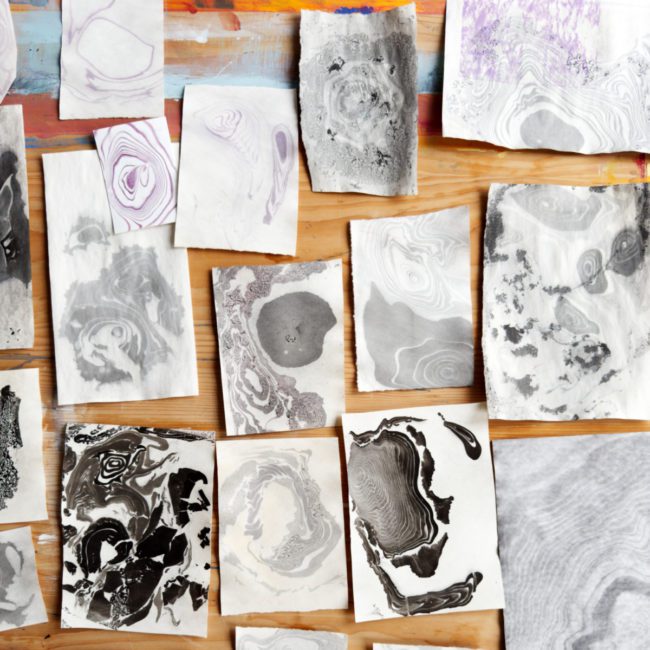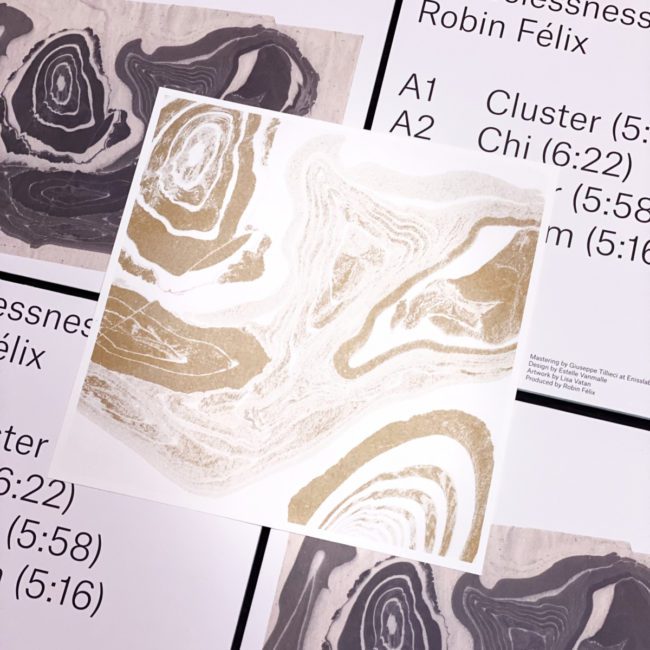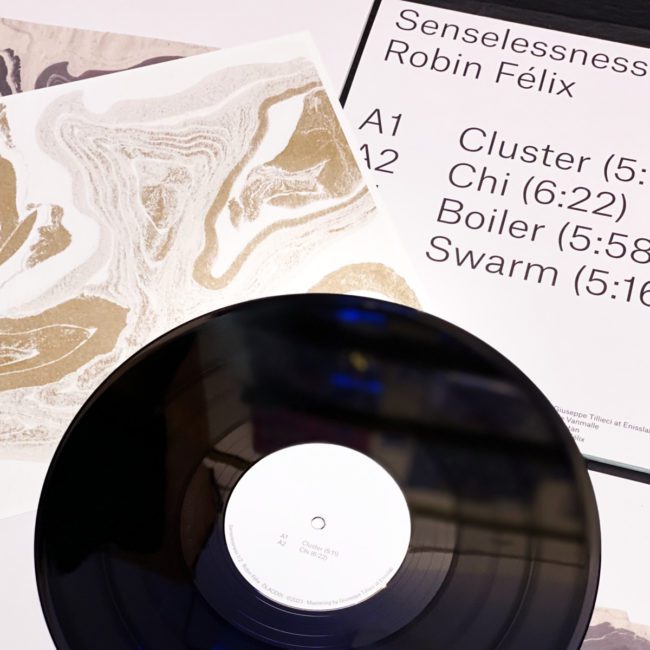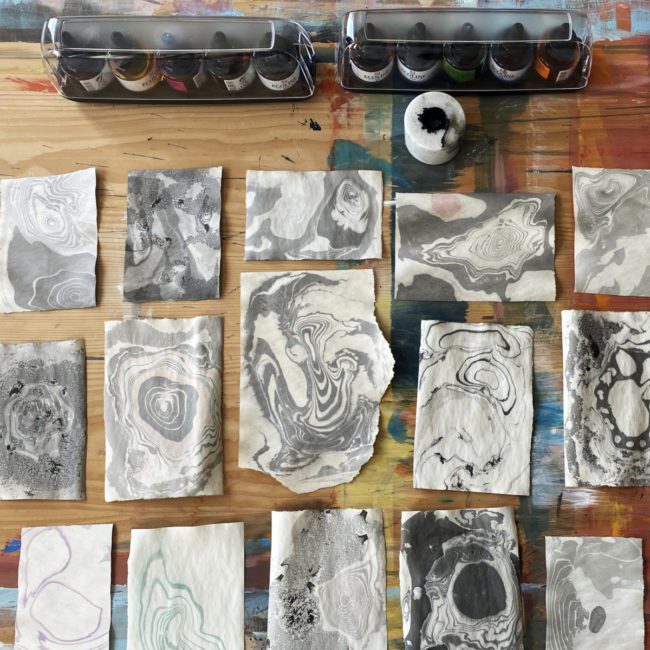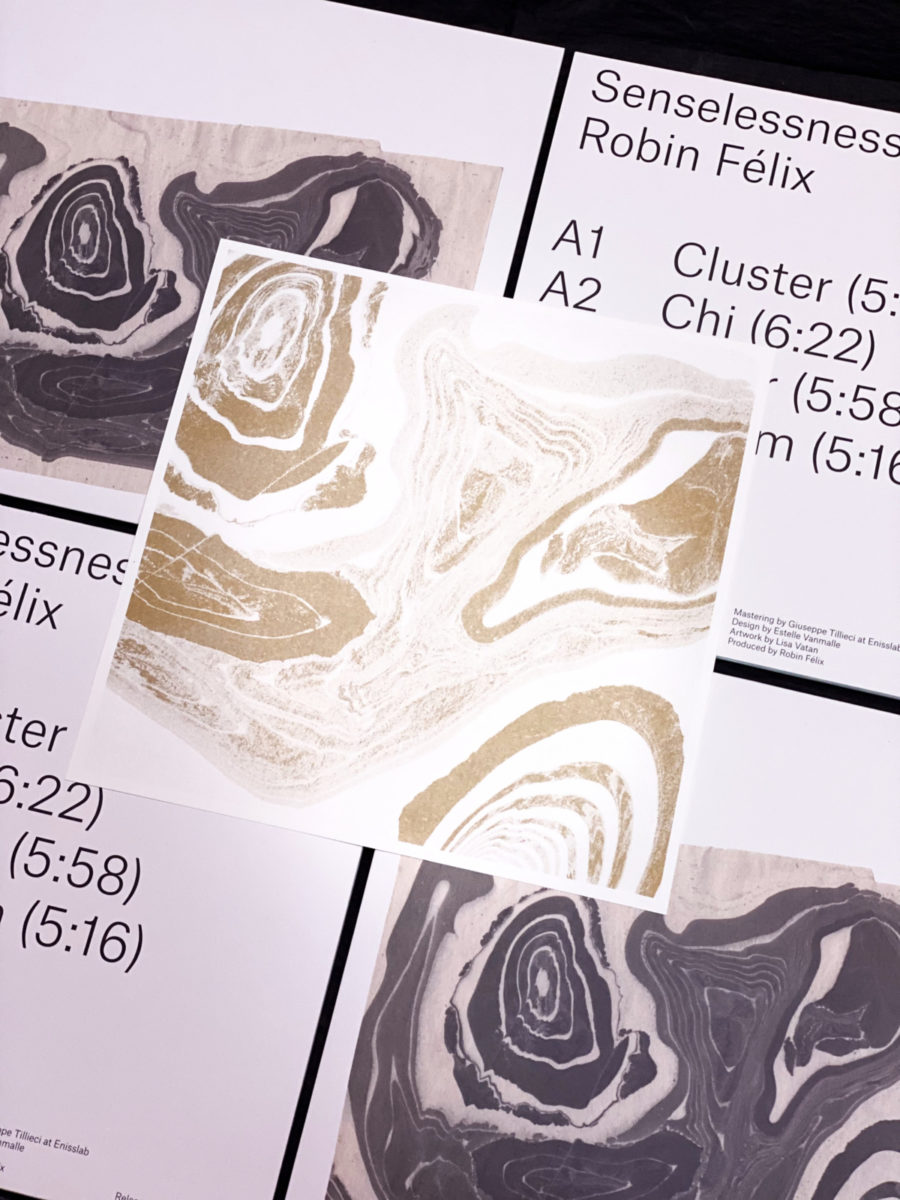Following the release of his inaugural extended player last year through his own De l’aube imprint, Swiss producer Robin Félix steps up to deliver the 377th edition of the IA MIX Series, interweaving a multi-rhythmic mix of textural ambient, breakbeat, IDM and experimental electronica.
Based out of the Swiss town of Biel/Bienne, Robin Félix is a self described audio naturalist, employing found sounds as the basis of his productions upon which he implies a strict rule to use at least 80% of field recording in his music. He then twists, skewers and manipulates these sounds to create the most mesmerising of sculptural sound-fields incorporating swirling radial ambiance and intricate drum work.
Mastered by Italian producer Neel, ‘Senselessness 1/2‘ EP is a beautifully crafted vinyl, presented in gold Risograph artwork designed by Lisa Vatan – inspired by the ancient Japanese paper marbling technique of Suminagashi. With such a bold debut effort, we just had to find out more about the makings of it.
In our interview, Robin sheds light on his musical background and penchant for field recordings as well as his minimalist production technique. We also find out more about his partner’s process behind the artwork and what they have planned in the near future for their freshly established record label De l’aube.
Interview by Tom Durston
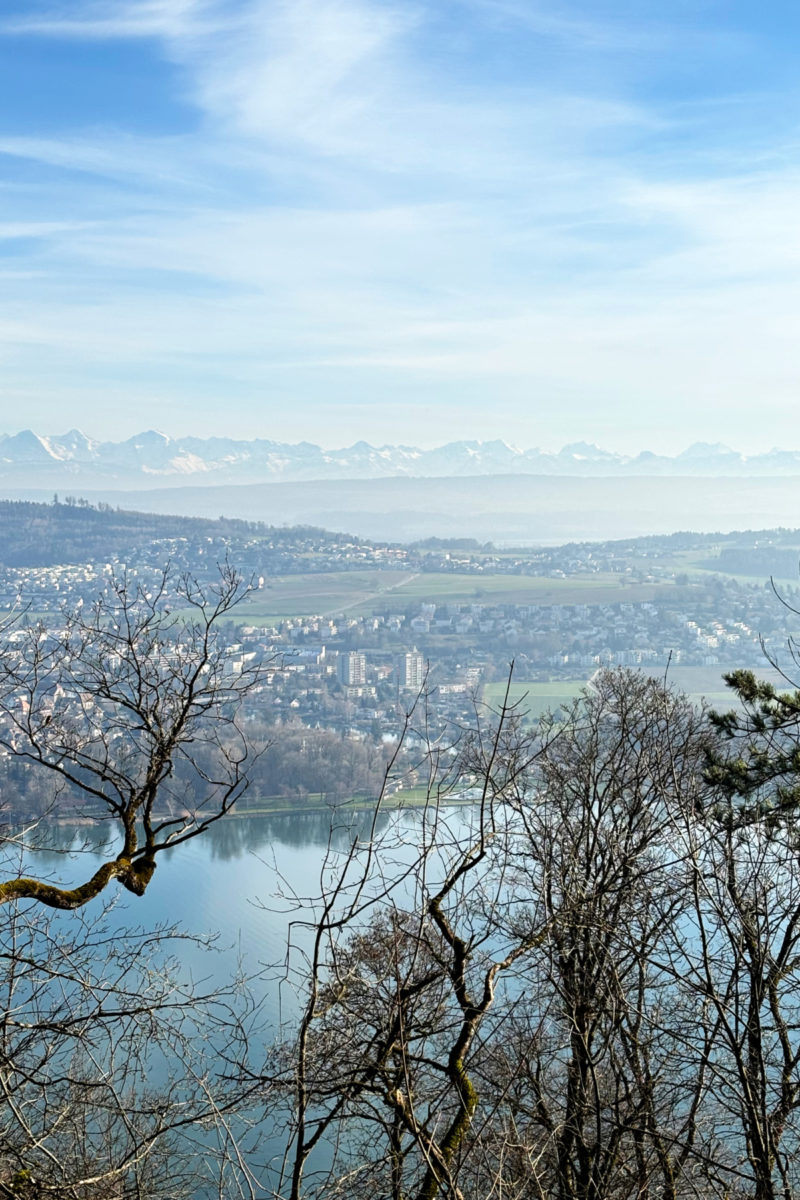
"I see my working process as a form of sculpture, where a sample can be sculpted, stretched, concentrated, cut, crushed and so on"
Thank you for taking the time to record your mix and answer my questions Robin. Please tell us how you approached this mix, where it was recorded and what atmosphere you have created?
Hello Tom, I’m very grateful to you for interviewing me, thank you! It’s an interesting question and not so easy to answer. To begin with, this mix was recorded in my music studio in the town of Biel/Bienne in Switzerland, where I currently live. Rather than offering you a description based on emotions or listing musical genres, I prefer to present you my vision, as I find the relationship between sound and image fascinating, and so everyone will interpret it in their own way.
My journey takes place in the heart of an Alpine landscape, characterised by a striking contrast between lakes and mountain ranges. Day breaks and, as the minutes pass, the weather changes and evolves rapidly. Life’s water-related processes are in action: evaporation, cloud formation, precipitation, thunderstorms, lightning. Finally, a return to tranquillity.
I would describe this musical evolution as a dynamic confrontation between matter and atmosphere. The diversity of Switzerland’s landscapes is a major source of inspiration for my work. During my travels, I am particularly receptive to the specific energies that emanate from them. I hope this brief visual description arouses your curiosity and inspires you to listen to my mix.
Last year you self-released your first ever vinyl release ‘Senselessness 1/2’, a stunning 4-track EP portraying abstract ambient, breakbeat and field recordings – it sounds like an amalgamation of Huerco S, Jan Jelinek and Skee Mask. Before we dive into that, I’d like to learn more about your musical beginnings, tell us who/what got you interested in electronic music?
First of all, thank you for qualifying and referencing this release by citing artists I really admire. When I was young, I wanted to play the drums, but the lack of a music room made it difficult to practice at home. So I turned to the piano and took classical music lessons until I was about 16 years old.
My memories of this period are positive, although I never excelled at music theory. Because of my dyslexia, reading sheet music was a challenge, so I learned my pieces by heart for auditions. This ear-based approach is still my preferred method today. Later, I joined a band at school as a keyboard player.
To answer your second question, my interest for electronic music was strongly marked during my six-month stay in New York in 2011, as an Erasmus exchange student. During that period, I attended numerous club nights and after-parties held in Brooklyn warehouses. These semi-illegal events, orchestrated by Blk Market and ReSolute in often abandoned warehouses (I’m not sure of their current existence), left me with unforgettable memories. Attending these gigs in these atypical locations was a life-changing experience for a 21-year-old like me, marking the beginning of my passion.
From then on, I started downloading music to mix at home. After my return to Switzerland, I founded La Serre, a collective with my close friends at the time, Philémon Otth and Sébastien Mennet. We organised raves in parallel with my art studies at ECAL in Lausanne, parties at the now-closed club “La Ruche, and once we even transported a big sound-system on a snowmobile to play on ski slopes, which was really fun. It was my debut in electronic music haha!
"I'm constantly on the lookout for sounds around me, instinctively drawing out my microphone to capture sound samples"
When you were growing up – what artists and albums did you absorb and relate to the most?
The first album that made a deep impression on me was “Luxor To Isna” by The Musicians Of The Nile, released on the Real World label headed by Peter Gabriel. My parents used to play it in the living room, and as a child, around the age of 3-4, archive videos show me dancing as if in a trance under the spell of those percussion instruments.
I was probably influenced by the jazz my parents listened to, with musicians such as Coltraine, Miles Davis, Sade Adu, Keith Jarret and Billie Holiday. My father was a big fan of Peter Gabriel, for whom I still have a great deal of admiration.
As a teenager, I got into lots of different musical genres, which is natural at that age, such as metal, French rap, reggae, dub and a bit of rock too. Then came electronic music, with landmark albums such as Pantha du Prince’s ‘Black Noise’, Nicolas Jaar’s ‘Space Is The Only Noise’, Floating Points’ ‘Shadows’ EP, Mount Kimbie’s ‘Crooks & Lovers‘, Four Tet’s ‘Pink‘ and Caribou’s ‘Swim‘.
Later came DJ’ing in Lausanne, with minimal and deep house. And still later, there was the meeting with Lisa, a big slap in the face in front of a live performance by Donato Dozzy at Terraforma in 2019, a baby… let’s just say it opened the door to a whole new world.
When did you start to create and experiment with your own music?
In 2018, I started by sampling old vinyl records, I found myself releasing my very first track entitled ‘Loov‘. Then, in 2019, I realised that the microphone could be a musical instrument, and I started recording everything with it: nature, voices, exhibitions, travels, parties and so on.
What is your local music scene like? We’d love to know where you tend to hang out and experience music.
The city of Biel/Bienne has the particularity of being bilingual, and this, I think, is its strength. It’s a city where culture reigns supreme, thanks to a host of events organised for the visual arts and music. In the 80s, La Coupole, a former gasworks converted into an alternative venue, earned the town a reputation for being underground. For example, French hip-hop duo IAM came here to play one of their first live shows in 1990 for a derisory fee.
The venue has recently been renovated and is once again hosting events. The city has very little club culture, but there are plenty of alternative, self-managed spaces, like the famous Gurzelen Stadium. The former soccer stadium of the city of Biel is now home to a multitude of projects, including “Tennis Champagne”, the only public tennis club in Switzerland where you can play on grass, “langSAMEr”, a huge community vegetable garden, “Mute Radio » , a skate park, the “Ying Yang mini club”, where friends organise parties called “TomTomKlub” in the former dressing rooms of soccer teams, and loads of other projects. It’s an unusual stadium. If you’re ever in Biel, it’s well worth a visit!
There is also the Summerfest Festival every year in this stadium, which gives the local scene a chance to express itself. In Biel, you can also find the “Minuit No Fun Co.” organisation, which invests in various Biel venues, offering weekly concerts. The Gärbi Breihaus, a restaurant-bar-concert venue that we love. The Atomic Café, also an emblematic café-concert venue. Lokal-int, a gallery that hosts a new exhibition and sometimes concerts/performances every Thursday.
I’m sure I’m forgetting to mention lots of wonderful places and organisations, but I’ll end with this: there’s a recurring event here, the “First Friday”, which as the name suggests is held every first Friday of the month, in Biel’s old town. On this occasion, all the shops stay open until late and can take over the street. There can be concerts, DJ sets in front of Cosmodisco (a fabulous record store), food stalls, crowded terraces, children, babies, grandmothers and so on. It all mixes together and generally creates something really cool. All in all, it’s a city imbued with a very punk mentality, which is very rare in this country and that we really like.
When we feel like going out to a club, we usually head to Elysia in Basel for the events organised by Amenthia Recordings, a Basel-based label run by Garçon and Agonis. I also want to express my gratitude to them because their music has greatly influenced me.
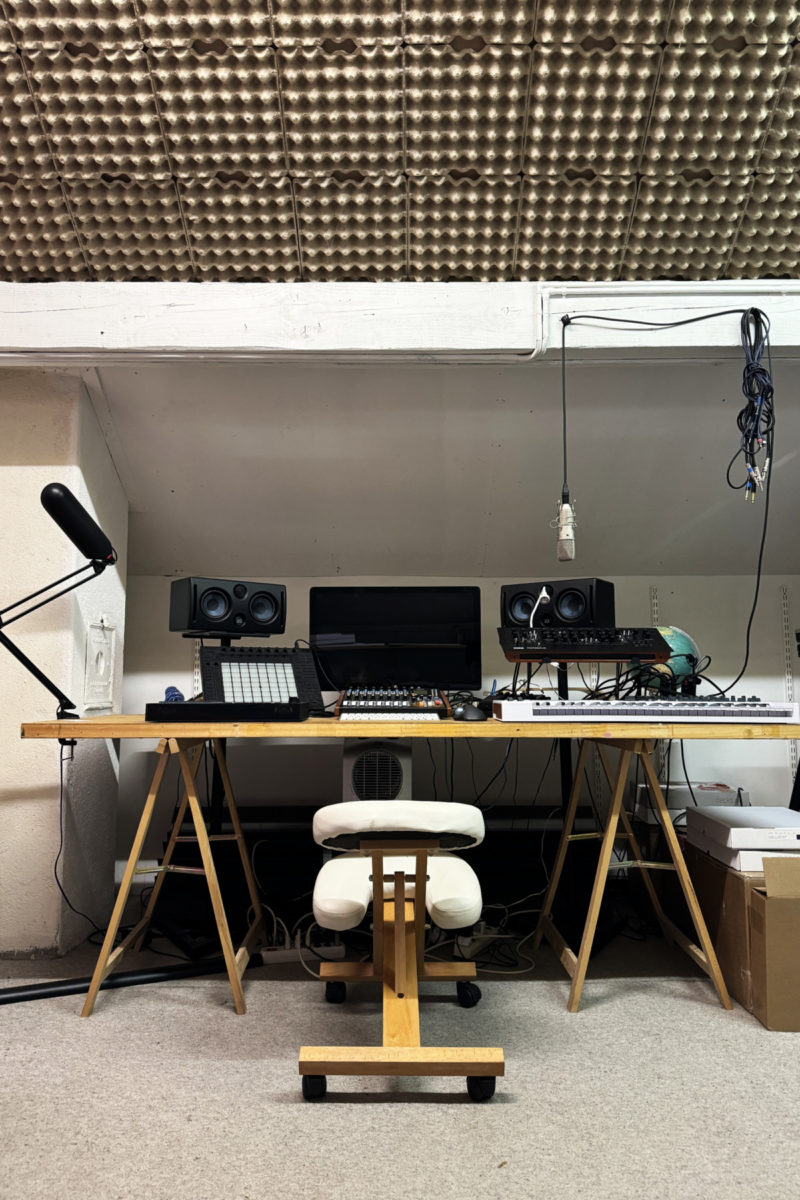
"Meaninglessness defines my approach, my philosophy of musical production, and the means I employ"
Field recordings appear to be integral to your production technique, how do you go about recording and manipulating your own found sounds?
Indeed, I define myself as an audio naturalist. I’m not inventing anything, this approach is shared by many artists. For me, field recordings are the raw material for my projects, like a visual artist using various materials to create a work of art. I’m constantly on the lookout for sounds around me, instinctively drawing out my microphone to capture sound samples.
My library of samples is organised as best I can, although sometimes it’s hard to remember when and where they were captured. No matter, I give them descriptive titles to facilitate my search for inspiration. Then I apply my own recipes for working with them.
Trained as a visual artist, I see my working process as a form of sculpture, where a sample can be sculpted, stretched, concentrated, cut, crushed and so on. Setting a constraint, such as the 80% use of field recording in my projects, keeps me focused and allows me to make the most of my samples. I exploit them in every possible way until they’re exhausted, and it’s amazing what can be created with this approach. Less is more!
Tell us about your current studio setup?
I set up at the top of an industrial building, in an artist’s studio with an attic, thus benefiting from excellent acoustics, a crucial element for music. As I mentioned, my working method is very minimalist, I use very few instruments. I make do with the bare essentials: an MPC, a synthesiser, effects pedals, and several very effective VST plugins and iPad applications that enable me to achieve my goals quickly.
When writing music – do you enter a specific mindset for a few hours, or do you piece together tracks together over a much longer period of time?
Alongside my music production, I teach visual arts and have a family life, which makes it difficult to concentrate 100% of my time on music. I go to the studio irregularly but at least once a week for a few hours, depending on the deadlines I set myself or that are imposed on me.
Right now, I’m working on a track for a compilation on a tight deadline, so I travel with my computer, my microphone as a sound card, and my iPad. Every free moment is precious to make progress on this project. It’s not necessary for me to start my projects in the studio, but when I finalise them and work on editing and mixing, yes. So, to answer your question, it depends on many factors.
What’s the concept behind ‘Senselessness 1/2’?
I’ve been working on this project for over a year now and intend to play it live sometime in 2024. In essence, meaninglessness defines my approach, my philosophy of musical production, and the means I employ. It’s a form of creation devoid of apparent logic, but which functions as it is thanks to contingencies of altered sonorities and rhythms, which, by chance, please me as they are.
We can only assume that ‘Senselessness 2/2’ is on the near horizon, will this continue in the same vein or be a totally different project to the first EP?
Yes, the second EP will follow the same guideline. The intention is for the two parts to form a whole. However, this is an experimental project in my eyes, with the chance and freedom to develop in another form. I’d rather not reveal any more than that.
Last year, you dropped off copies of ‘Senselessness 1/2’ to the Inverted Audio Record Store in Peckham – thank you! From what I recall, ‘Swarm’ is composed from recordings of insects rubbing their wings together – manipulated by you to create turbine whirring sounds – what insects are they and how did you capture this / manipulate it for the track?
In the company of my partner Lisa and my son Basil, who was very small at the time, we were walking in the forest above our house, when a swarm of flies hovered above us, a few centimetres above the ground. I don’t know if we gave off any particular scent, but in any case, the cloud of flies followed us.
The natural sound emanating from it was truly captivating and enchanting. I distinctly remember recording them with my arm raised, taking care to make as little noise as possible, as they produced an extremely tinny sound. The exact details of the effects I added to this track escape me now, but it’s quite possible that I manipulated the tones using a rack of plugins, mainly altering the characteristics towards more dub and granular oriented nuances.
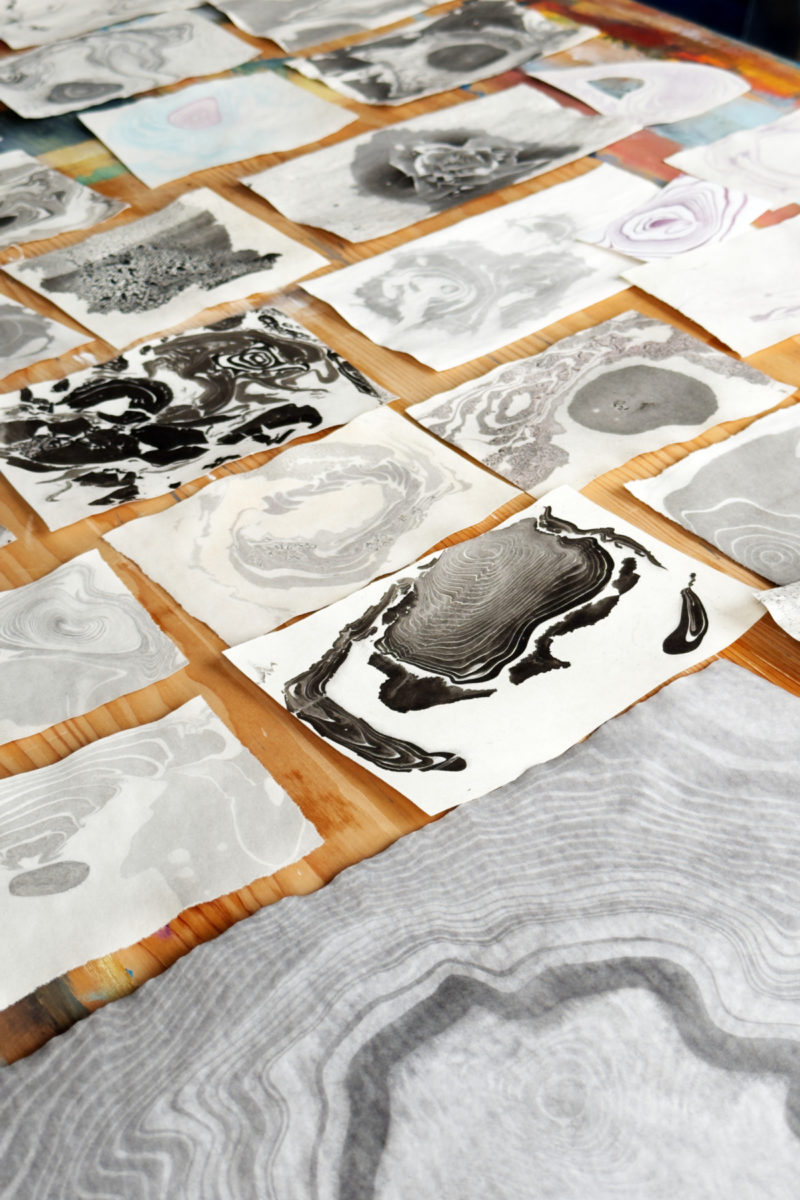
"The gesture used to immerse the paper in the water also influences the impression and visual aspect. As with the way I approach my musical projects, there's this idea that chance can do things right"
Your partner Lisa Vatan created and designed the artwork for the vinyl release fronted with a Risograph print inspired by the ancient Japanese paper marbling technique Suminagashi. It looks fantastic with the gold print. Please tell us more about the design process and what made you settle for the Suminagashi technique?
I’m delighted it’s having an impact. In fact, it’s a Japanese technique dating back to the 12th Century, considered to be the ancestor of marbling. Lisa attended a workshop lasting several days to learn how to make Suminagashi.
This process is quite experimental, as the result depends on many factors such as the type of paper, the quality of the water and even the ink used. The gesture used to immerse the paper in the water also influences the impression and visual aspect. As with the way I approach my musical projects, there’s this idea that chance can do things right.
Suminagashis are also very economical, requiring few ingredients and few gestures, just as I want for my music. It is also an aqueous technique; and as we know, water can be deep, mysterious. Calm or agitated, ice or steam. And I really like this idea. All in all, it’s a technique that fits in perfectly with ‘Senselessness‘ and illustrates its themes to perfection.
What’s your vision for the De l’aube imprint? Do you plan to only release solo productions, or from other like-minded artists?
De l’aube aspires to transcend the simple label of a music label with vinyl releases. Our project is experimental in the sense that we seek to explore various universes, techniques and production media, creating a synergy between sound and image.
For example, we might consider publishing a book or fanzine accompanied by a sound project, or inviting artists to perform in spaces dedicated to contemporary art. As Lisa and I both studied at art school, our aim is to create projects that will appeal to both visual and sound artists.
Looking ahead, what do you have planned to achieve in 2024?
We gave complete artistic freedom to a duo comprising a painter and a musician specialising in electronic music with modular instruments. This tandem is accustomed to organising encounters highlighting their distinct practices, but centred on improvisation. At present, I can’t provide any further details on the form this project will take, nor on the format chosen for its presentation. Senselessness 2/2 will also be in progress this year. So we are pretty sure something will see the light of day in 2024.
Finally, do you have anything else that you’d like to share?
I’d like to share with readers, artists and promoters that I’m open to all kinds of collaborations, and that I’d be delighted to be able to play “Senselessness” live this year, if I get the chance.
‘Senselessness 1/2’ is out now via De l’aube. Order a vinyl copy from Inverted Audio Store and digital from Bandcamp.
TRACKLIST
1. The Vision Reels – Rebirth (Senseless Override) [re:st]
2. Lemont – Submerged [A Walking Contradiction]
3. HVL – dromo [HVL]
4. Robin Félix – Cluster [De l’aube]
5. Hngwy – LumLung [Nous Disques]
6. Syz – Botanic Receptors [Syz]
7. Andrea – Jaim [Ilian Tape]
8. DYL + DB1 – ECOU #11 [re:st]
9. Keplrr x Human Resources – Spring [Pressue Dome]
10. Soreab – Insomnias [Avian]
11. Big Hands – Calix’s Head [Oscilla Sound]
12. Konsudd – Heilen [Amenthia Recordings]
13. ASC – Scanners [Advanced Scientific Concepts]
14. Konduku – Mantar Kaya [Spazio Disponibile]
15. Lemna – Spinning Dancer [Delsin]
16. Camboja – Happy For Some Mysterious Reason (Big Hands Plastic Smile Remix) [Pho Bho Records]
17. Soreab – Dust Eater [Avian]
18. GLASKIN – Hydrogroove I [Yael Trip]
19. Tammo Hesselink – First Supposed [Blank Mind]
20. Robin Félix – Ponant [Unreleased]
21. Robin Félix – Chi [De l’aube]

